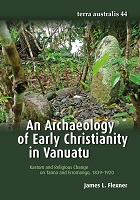An Archaeology of Early Christianity in Vanuatu (Terra Australis 44)
Kastom and Religious Change on Tanna and Erromango, 1839–1920
Abstract
Religious change is at its core a material as much as a spiritual process. Beliefs related to intangible spirits, ghosts, or gods were enacted through material relationships between people, places, and objects. The archaeology of mission sites from Tanna and Erromango islands, southern Vanuatu (formerly the New Hebrides), offer an informative case study for understanding the material dimensions of religious change. One of the primary ways that cultural difference was thrown into relief in the Presbyterian New Hebrides missions was in the realm of objects. Christian Protestant missionaries believed that religious conversion had to be accompanied by changes in the material conditions of everyday life. Results of field archaeology and museum research on Tanna and Erromango, southern Vanuatu, show that the process of material transformation was not unidirectional. Just as Melanesian people changed religious beliefs and integrated some imported objects into everyday life, missionaries integrated local elements into their daily lives. Attempts to produce ‘civilised Christian natives’, or to change some elements of native life relating purely to ‘religion’ but not others, resulted instead in a proliferation of ‘hybrid’ forms. This is visible in the continuity of a variety of traditional practices subsumed under the umbrella term ‘kastom’ through to the present alongside Christianity. Melanesians didn’t become Christian, Christianity became Melanesian. The material basis of religious change was integral to this process.
Keywords
vanuatu; archaelogy; religion; Erromango; James Thomas Flexner; Melanesians; Missionary; New Hebrides; Tanna Island; Terra AustralisDOI
10.22459/TA44.12.2016ISBN
9781760460747OCN
1030820286Publisher
ANU PressPublisher website
https://press.anu.edu.au/Publication date and place
2016Classification
Melanesia
Vanuatu
Archaeology
Religion and beliefs


 Download
Download Web Shop
Web Shop